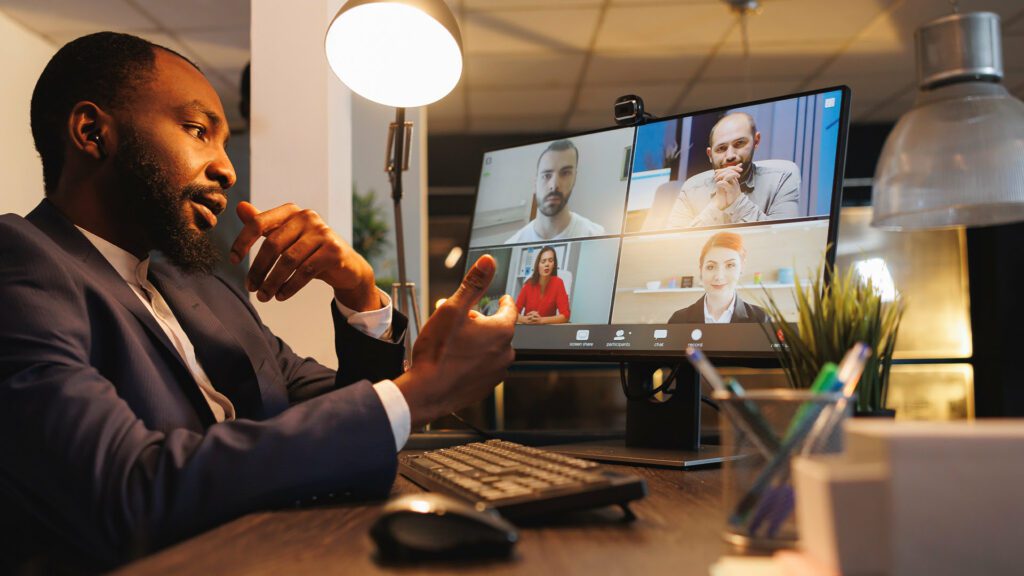Summary
- Video conferencing technology is already changing the way justice is administered in courts and correctional facilities—making it easier to process cases, participate in hearings remotely, and deliver essential services to inmates in jails and prisons.
- As this technology becomes more widely available, it will be imperative to choose systems that focus on accessibility, cost-effectiveness, user experience, and safety.
- ET Group Justice Solutions uses features like online scheduling, virtual breakout rooms, and automated translation and transcription services to improve access for participants during court hearings and streamline cases. They can also help protect vulnerable witnesses by concealing their identity and eliminating the need for them to physically appear in courtrooms.
- Our correctional audio visual solutions can improve the quality and frequency of visits for inmates by facilitating video visitations with their loved ones. The same technology can also improve access to essential services via telehealth and remote delivery of educational programs, while removing costs and liabilities for correctional institutions.
The Benefits of Using Video Conferencing Technology in Courts & Correctional Facilities
As courtrooms and correctional facilities throughout North America face an increasing backlog in the number of cases completed and challenges related to inmate quality of life, video conferencing technology has profound potential to improve the efficiency of our justice system—from remote hearings to video visitation, telehealth, and the delivery of remote educational programs for inmates.
ET Group Justice Solutions are designed to improve both the efficiency with which these important institutions function and the experience of all people connected to them. Below, we explore five of the most important benefits video conferencing technology provides in this context.
See Also:
Transforming & Innovating Technology Infrastructure
Courtroom technology began to expand significantly throughout North America following the outbreak of the COVID-19 pandemic. In the United States, various groups including the Conference of Chief Justices (CCJ) and the Conference of State Court Administrators (COSCA) requested that courts use technology to improve communication for litigants during hearings.
According to the Pew Charitable Trusts, the adoption of this technology was unprecedented in both size and scale. Specifically, video conferencing was cited as an effective way to move hearings online, thereby resolving many cases that would otherwise have been delayed.
Technology that Supports Equality
Following the pandemic, it became clear that while this technology had obvious and exciting implications, it also created certain difficulties—specifically, for people with disabilities, limited English proficiency, or no access to high-speed internet. Many courts have since mandated that the use of video conferencing technology in courtrooms must “ensure principles of due process, procedural fairness, transparency, and equal access are satisfied when adopting new technologies.”
This evidence points to an urgent and ongoing need to modernize courtrooms—not only in North America but around the world. Our focus at ET Group is to promote, standardize, and simplify the virtual infrastructure that makes these kinds of efficiencies possible.
Increasing Access to Justice
One of the easiest ways to measure the success of new technology is to look at the material benefits it provides for the people who use it. That philosophy, which is at the heart of our hybrid workplace solutions for enterprise organizations, applies just as much to the technology we develop and implement for courts and correctional facilities.
At ET Group, we believe that justice is only served when it’s served equally. Here are some of the ways in which our video conferencing technology is designed to benefit litigants, inmates, and the people connected to them:
- Easier remote participation during hearings via cloud-based online scheduling and breakout rooms
- Support for people with disabilities via video recording, assistive listening, large-format displays, and audio uplift.
- Interpretation and translation services to benefit participants whose second language is English.
- Accessible cameras for video visitation stations in correctional facilities.

Reducing Operational Costs
Improving the efficiency of courts and correctional facilities does more than save time—it also saves money. For governments and private organizations that administer these facilities, this makes resources available to allocate towards other services and quality of life improvements. Here’s how:
- Reduces travel and transportation. Virtual courtrooms with external evidence-sharing features significantly reduce the costs of setting up hearings, and using video conferencing technology in correctional facilities eliminates the need to escort inmates to and from visitation rooms.
- Lower staffing requirements. Correctional facilities benefit significantly from video visitation technology, since it removes the need for on-site personnel to handle visitor check-in and registration.
- Increases ROI on tech infrastructure. Money saved on staffing and transportation helps offset the costs of video conferencing technology for hybrid courtrooms and correctional facilities.
Improving Service Delivery
Standardizing the video conferencing tech used across the justice system reduces the potential for compatibility issues and ensures important information is not lost while improving user experience and delivering faster results. Our solutions focus on improving service in the following ways:
- Simple and easy-to-use technology improves accessibility for all end users in courtrooms and correctional facilities. Our correctional video endpoints are designed as all-in-one units that provide a straightforward user experience in a secure and vandal-resistant package, while our FlexVideo carts offer a plug-and-play mobile courtroom video experience that can hybridize any courtroom in minutes.
- Delivering justice faster means more cases are processed and more people get closure. From making remote participation easier to automating tasks like transcription and translation, the time and resources saved by using our video conferencing solutions translate directly into faster resolutions for individuals.
- Self-service tools like the scheduling and wayfinding features in our HybridCourts™ solutions help eliminate administrative overhead for institutions while giving users agency over scheduling, submitting documentation, and more.
- Enhanced customer service experience via remote technology support designed specifically for justice applications. Our JusticeSupport™ services provide detailed analytics, remote monitoring, and room testing, and access to a dedicated help desk to proactively diagnose and address challenges—as well as 24-hour on-site support from certified AV technicians when necessary.
Increasing Safety
Ultimately, the justice system exists to provide security for people—so any video conferencing technology used in courtrooms or correctional facilities must make safety a top priority. This concept applies equally to two vital areas:
- Making justice more accessible during public emergencies like pandemics or natural disasters. The value of virtual courtroom technology in these situations is already clear, but investing in the right technology support is also vital for ensuring reliability during periods of increased uncertainty or instability.
- Improving the safety of inmates and vulnerable populations by using technology that protects essential information and reduces risk during hearings, visitations, or other activities. For example:
- Protecting vulnerable witnesses in remote courtroom hearings via multi-camera features and control systems that help prevent their identities from being revealed.
- Facilitating remote court appearances and defense access for jail inmates to eliminate the risks of transporting them in public during trials.
- Enabling remote access to healthcare, educational, and consultative services to reduce opportunities for inmates to come into conflict with each other and improve access to these services by eliminating problems related to scheduling or overcrowding.
Bringing Justice into Focus for the Modern Era
Video conferencing technology is already fundamentally transforming the way justice is administered in modern courtrooms and correctional facilities. Using this technology to its full potential requires a standardized approach that prioritizes increased access, cost-efficient technology, and a focus on service and safety.
Learn more about our HybridCourts™ and correctional video solutions by contacting ET Group Justice Solutions and speaking with an audio visual expert who can walk you through the best ways to use these tools for your organization. With our help, justice can be faster, more efficient, and available to a wider number of people than ever before.
Frequently Asked Questions about Video Conferencing Technology in Courtrooms & Correctional Facilities
Who benefits most from hybrid and virtual courtroom technology?
Hybrid courtroom technology benefits the people who administer justice and the people who rely on them. Here are a few examples:
- Remote participants (including litigants and police) via online scheduling, recordings, and virtual breakout rooms.
- Vulnerable witnesses via multi-camera technology, picture-in-picture mode, and identity protection controls.
- Juries via ceiling speakers, tracking cameras, large-format displays, and other accessibility features.
- Courtroom staff via evidence presentation tools, automated translation and transcription, mobile video carts, assistive listening, and more.
- Correctional staff and inmates via vandal-resistant devices, accessible cameras, and private calling.
What activities can correctional video technology support?
Our video conferencing systems for correctional facilities make the following activities safer, more cost-effective, and easier to coordinate:
- Remote Court Appearances: Inmates can join their court hearings from jail, without needing to be physically moved to the courtroom.
- Defense Access: Inmates can talk privately with their lawyers over video.
- Family Visitations: Video visitation technology helps inmates see and speak with their family members through video calls—and makes visitations easier for loved ones.
- Consultative Services: Offers ways for inmates to get advice or counseling over video.
- Educational Programs: Inmates can learn or train through online classes and programs.
- Telehealth: Inmates can have medical check-ups or talk to a doctor or therapist over video.
What correctional video systems does ET Group offer?
Our video conferencing hardware for correctional facilities includes a few different options:
- SecureV200 (For Cisco Webex Room Kit Mini): Best for small, confined spaces like private offices or small meeting rooms. It’s a secure, easy-to-install system with a wall-fastened cabinet and clear audio and video capabilities.
- SecureV250 (For Cisco Webex Room Kit): Similar to SecureV200, it’s also ideal for smaller rooms needing secure video conferencing solutions, with added features for clear audio transmission and durability.
- SecureV300/V300 Pro (For Cisco Webex Desk/Desk Pro): Suitable for slightly larger spaces that require more equipment storage. Offers touchscreen compatibility and enhanced security for more dynamic conferencing setups.
SecureMobile (For Cisco Webex Room Kit): Perfect for flexible, open spaces where equipment needs to be moved frequently. Offers mobility with lockable wheels and handles, along with secure and clear audio-visual capabilities.
Stay connected with us:
Follow ET Group on LinkedIn
Subscribe to ET Group’s YouTube Channel









